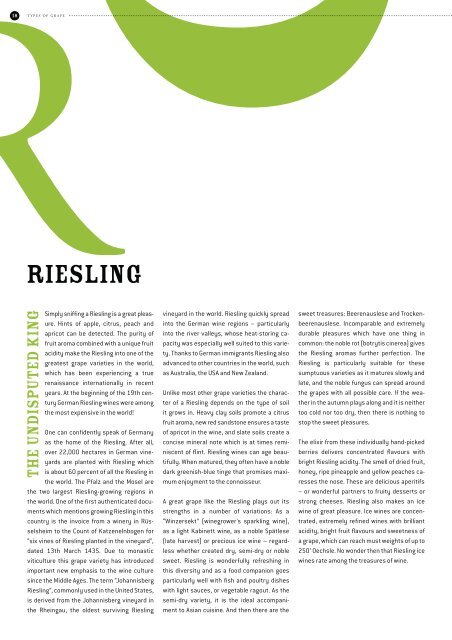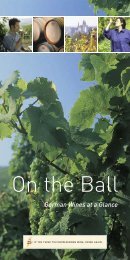the magazine of the german wine institute - Wines of Germany
the magazine of the german wine institute - Wines of Germany
the magazine of the german wine institute - Wines of Germany
You also want an ePaper? Increase the reach of your titles
YUMPU automatically turns print PDFs into web optimized ePapers that Google loves.
18 TYPES OF GRAPE<br />
RIESLING<br />
<strong>the</strong> undisputed king<br />
Simply sniffing a Riesling is a great pleasure.<br />
Hints <strong>of</strong> apple, citrus, peach and<br />
apricot can be detected. The purity <strong>of</strong><br />
fruit aroma combined with a unique fruit<br />
acidity make <strong>the</strong> Riesling into one <strong>of</strong> <strong>the</strong><br />
greatest grape varieties in <strong>the</strong> world,<br />
which has been experiencing a true<br />
renaissance internationally in recent<br />
years. At <strong>the</strong> beginning <strong>of</strong> <strong>the</strong> 19th century<br />
German Riesling <strong>wine</strong>s were among<br />
<strong>the</strong> most expensive in <strong>the</strong> world!<br />
One can confidently speak <strong>of</strong> <strong>Germany</strong><br />
as <strong>the</strong> home <strong>of</strong> <strong>the</strong> Riesling. After all,<br />
over 22,000 hectares in German vineyards<br />
are planted with Riesling which<br />
is about 60 percent <strong>of</strong> all <strong>the</strong> Riesling in<br />
<strong>the</strong> world. The Pfalz and <strong>the</strong> Mosel are<br />
<strong>the</strong> two largest Riesling-growing regions in<br />
<strong>the</strong> world. One <strong>of</strong> <strong>the</strong> first au<strong>the</strong>nticated documents<br />
which mentions growing Riesling in this<br />
country is <strong>the</strong> invoice from a <strong>wine</strong>ry in Rüsselsheim<br />
to <strong>the</strong> Count <strong>of</strong> Katzenelnbogen for<br />
“six vines <strong>of</strong> Riesling planted in <strong>the</strong> vineyard”,<br />
dated 13th March 1435. Due to monastic<br />
viticulture this grape variety has introduced<br />
important new emphasis to <strong>the</strong> <strong>wine</strong> culture<br />
since <strong>the</strong> Middle Ages. The term “Johannisberg<br />
Riesling”, commonly used in <strong>the</strong> United States,<br />
is derived from <strong>the</strong> Johannisberg vineyard in<br />
<strong>the</strong> Rheingau, <strong>the</strong> oldest surviving Riesling<br />
vineyard in <strong>the</strong> world. Riesling quickly spread<br />
into <strong>the</strong> German <strong>wine</strong> regions – particularly<br />
into <strong>the</strong> river valleys, whose heat-storing capacity<br />
was especially well suited to this variety.<br />
Thanks to German immigrants Riesling also<br />
advanced to o<strong>the</strong>r countries in <strong>the</strong> world, such<br />
as Australia, <strong>the</strong> USA and New Zealand.<br />
Unlike most o<strong>the</strong>r grape varieties <strong>the</strong> character<br />
<strong>of</strong> a Riesling depends on <strong>the</strong> type <strong>of</strong> soil<br />
it grows in. Heavy clay soils promote a citrus<br />
fruit aroma, new red sandstone ensures a taste<br />
<strong>of</strong> apricot in <strong>the</strong> <strong>wine</strong>, and slate soils create a<br />
concise mineral note which is at times reminiscent<br />
<strong>of</strong> flint. Riesling <strong>wine</strong>s can age beautifully.<br />
When matured, <strong>the</strong>y <strong>of</strong>ten have a noble<br />
dark greenish-blue tinge that promises maximum<br />
enjoyment to <strong>the</strong> connoisseur.<br />
A great grape like <strong>the</strong> Riesling plays out its<br />
strengths in a number <strong>of</strong> variations: As a<br />
“Winzersekt” (<strong>wine</strong>grower’s sparkling <strong>wine</strong>),<br />
as a light Kabinett <strong>wine</strong>, as a noble Spätlese<br />
(late harvest) or precious ice <strong>wine</strong> – regardless<br />
whe<strong>the</strong>r created dry, semi-dry or noble<br />
sweet. Riesling is wonderfully refreshing in<br />
this diversity and as a food companion goes<br />
particularly well with fish and poultry dishes<br />
with light sauces, or vegetable ragout. As <strong>the</strong><br />
semi-dry variety, it is <strong>the</strong> ideal accompaniment<br />
to Asian cuisine. And <strong>the</strong>n <strong>the</strong>re are <strong>the</strong><br />
sweet treasures: Beerenauslese and Trockenbeerenauslese.<br />
Incomparable and extremely<br />
durable pleasures which have one thing in<br />
common: <strong>the</strong> noble rot (botrytis cinerea) gives<br />
<strong>the</strong> Riesling aromas fur<strong>the</strong>r perfection. The<br />
Riesling is particularly suitable for <strong>the</strong>se<br />
sumptuous varieties as it matures slowly and<br />
late, and <strong>the</strong> noble fungus can spread around<br />
<strong>the</strong> grapes with all possible care. If <strong>the</strong> wea<strong>the</strong>r<br />
in <strong>the</strong> autumn plays along and it is nei<strong>the</strong>r<br />
too cold nor too dry, <strong>the</strong>n <strong>the</strong>re is nothing to<br />
stop <strong>the</strong> sweet pleasures.<br />
The elixir from <strong>the</strong>se individually hand-picked<br />
berries delivers concentrated flavours with<br />
bright Riesling acidity. The smell <strong>of</strong> dried fruit,<br />
honey, ripe pineapple and yellow peaches caresses<br />
<strong>the</strong> nose. These are delicious aperitifs<br />
– or wonderful partners to fruity desserts or<br />
strong cheeses. Riesling also makes an ice<br />
<strong>wine</strong> <strong>of</strong> great pleasure. Ice <strong>wine</strong>s are concentrated,<br />
extremely refined <strong>wine</strong>s with brilliant<br />
acidity, bright fruit flavours and sweetness <strong>of</strong><br />
a grape, which can reach must weights <strong>of</strong> up to<br />
250° Oechsle. No wonder <strong>the</strong>n that Riesling ice<br />
<strong>wine</strong>s rate among <strong>the</strong> treasures <strong>of</strong> <strong>wine</strong>.



